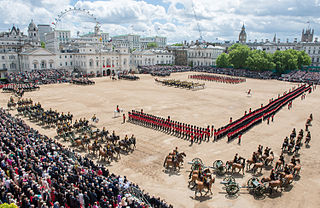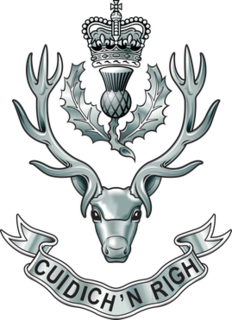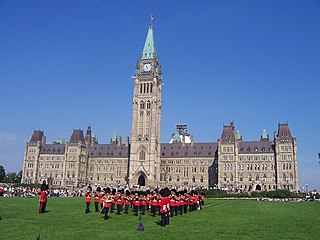Related Research Articles

Trooping the Colour is a ceremony performed every year in London, United Kingdom, by regiments of the British Army. Similar events are held in other countries of the Commonwealth. Trooping the Colour has been a tradition of British infantry regiments since the 17th century, and since 1748 has marked the official birthday of the British sovereign, although its roots go back much earlier.

The Royal Regiment of Fusiliers is an infantry regiment of the British Army, part of the Queen's Division. Currently, the regiment has two battalions: the 1st battalion, part of the Regular Army, is an armoured infantry battalion based in Tidworth, Wiltshire, and the 5th battalion, part of the Army Reserve, recruits in the traditional fusilier recruiting areas across England. The Royal Regiment of Fusiliers was largely unaffected by the infantry reforms that were announced in December 2004, but under the Army 2020 reduction in the size of the Army, its second battalion was merged into the first in 2014.
Options for Change was a restructuring of the British Armed Forces in summer 1990 after the end of the Cold War.

The Royal Gloucestershire, Berkshire and Wiltshire Regiment was a short-lived infantry regiment of the British Army.

The Royal Gibraltar Regiment is the home defence unit, part of British Forces Gibraltar for the British overseas territory of Gibraltar. It was formed in 1958 from the Gibraltar Defence Force as an infantry unit, with an integrated artillery troop. The regiment is included in the British Army as a defence engagement force. In 1999, the regiment was granted the Royal title. The regiment recruits from Gibraltar, the United Kingdom, Republic of Ireland and the Commonwealth.

The Royal Highland Fusiliers, 2nd Battalion, The Royal Regiment of Scotland is an infantry battalion of the Royal Regiment of Scotland.

Beating Retreat is a military ceremony dating to 17th-century England and was first used to recall nearby patrolling units to their castle.
The Duke of Edinburgh's Royal Regiment was an infantry regiment of the British Army.
The Rifles is an infantry regiment of the British Army. Formed in 2007, it consists of four Regular battalions and three Reserve battalions, plus a number of companies in other Army Reserve battalions. Each battalion of The Rifles was formerly an individual battalion of one of the two large regiments of the Light Division. Since formation the regiment has been involved in combat operations, first in the later stages of the Iraq War and in the War in Afghanistan.

The Queen's Own Highlanders , officially abbreviated "QO HLDRS," was an infantry regiment of the British Army, part of the Scottish Division. It was in existence from 1961 to 1994.

The Royal Marines Band Service is the musical wing of the Royal Navy and an independent element of the Royal Marines. It currently consists of five bands plus a training wing – the Royal Marines School of Music at HMS Nelson – and its headquarters is at HMS Excellent, Whale Island, Portsmouth.

The Royal Regiment of Scotland is the senior and only Scottish line infantry regiment of the British Army Infantry. It consists of three regular and two reserve battalions, plus an incremental company, each formerly an individual regiment. However, three regular battalions maintain their former regimental pipes and drums to carry on the traditions of their antecedent regiments.

The Wiltshire Regiment was a line infantry regiment of the British Army, formed in 1881 under the Childers Reforms by the amalgamation of the 62nd (Wiltshire) Regiment of Foot and the 99th Duke of Edinburgh's (Lanarkshire) Regiment of Foot.
The Lowland Band of the Royal Regiment of Scotland is a Military band in the Territorial Army and one of three Military bands in the Royal Regiment of Scotland. The band is based at the East Claremont Street drill hall in Edinburgh and is administered by 52nd Lowland, 6th Battalion, The Royal Regiment of Scotland. The other two bands in the Regiment are the regular Regimental Band of the Royal Regiment of Scotland, which is based at Dreghorn Barracks in Edinburgh and is administered by the Royal Corps of Army Music, and the other is the territorial Highland Band of the Royal Regiment of Scotland, which is based at Queen's Barracks in Perth and administered by 51st Highland, 7th Battalion, The Royal Regiment of Scotland.

The Band of the Ceremonial Guard is an ad hoc military band that is attached to the Canadian Forces Ceremonial Guard in Ottawa. All members of the band are fully trained members of the Canadian Armed Forces (CAF) and consists of personnel principally from the two Foot Guards regiments and has even since 2007 been manned by a pan–Canadian Forces approach that is inclusive to musicians from the Royal Canadian Navy, Canadian Army and Royal Canadian Air Force. The band forms a separate company within the CG and rely on the Headquarters Company for administration and support personnel. In full composition, the band is active from April to August.

The Central Band of the Royal Malay Regiment is the official central band of the Malaysian Army's Royal Malay Regiment that is dedicated to providing ceremonial honours and music to the Yang di-Pertuan Agong, the Prime Minister, the Chief Justice, the President of the Senate, and the Speaker of the House of Representatives. It is the Army's seniormost band. It is considered the equivalent to the 5 regimental bands of the Foot Guards.
The Band and Bugles of the Rifles is a military band serving as the regimental band for The Rifles, the sole rifle regiment and the largest in the British Army. It is the senior most of three bands in the regiment and is the only one that is part of the regular army. Uniquely, it employs bugles at its front, a tradition that goes back to the conflicts of the 18th century. Major Séan O’Neill is currently serving as the Director of Music (DOM) of the band and bugles. It is part of the Royal Corps of Army Music.
The Band of the Royal Irish Regiment is a military band serving as the regimental band for Royal Irish Regiment and the chief Irish military reserve band in the British Army. Being a reserve band, with is composed of volunteer musicians with the exception of a permanent staff instructor.

Military bands in the United Kingdom are the musical units that serve for protocol and ceremonial duties as part of the British Armed Forces. They have been the basis and inspiration for many military bands in the former British Empire and the larger Commonwealth of Nations as well as musical organizations in other countries. Military musical units with British influence include United States military bands, the Japan Ground Self-Defense Force Music Corps and the Military Band of Athens. British military bands are controlled by the military music departments of the three services that compose the armed forces. These include the Royal Marines Band Service, the Royal Corps of Army Music, and the Royal Air Force Music Services. British style brass bands and carnival bands were then and are currently inspired by the British Armed Forces and its brass bands, especially of the Army's regular and reserve formations, as they follow a similar format as it relates to brass and percussion instruments.
References
- ↑ "Drummers Call".
- ↑ "Regimental Music :: The Wardrobe".
- ↑ "IRA Killings Follows Lull In Terrorist Attacks Outside Britain With AM-Netherlands-Ira, Bjt". AP. 1 May 1988. Retrieved 20 January 2020.
- ↑ "IRA Bombs British Band On Belgian Visit". 29 August 1979. Retrieved 20 January 2020– via www.washingtonpost.com.
- ↑ https://api.parliament.uk/historic-hansard/written-answers/1985/may/02/service-bands [ dead link ]
- 1 2 3 "The Duke of Edinburgh's Royal Regiment (Berkshire and Wiltshire): Post war history". The Wardrobe. Retrieved 18 January 2020.
- ↑ Potter, John (2001). Testimony to Courage: The History of the Ulster Defence Regiment 1969-1992. Pen and Sword. p. 291. ISBN 978-0850528190.